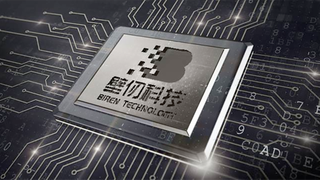US Prohibits Exports of Nvidia's A800 and H800 to China, Blacklists Chinese GPU Developers
The Biden administration restricts exports of more AI and HPC GPU to China.

In a bid to thwart the development of artificial intelligence (AI) technologies in China, the U.S. government this week imposed further restrictions on exports of AI and HPC GPUs to the People's Republic and blacklisted two Chinese GPU developers, reports Reuters. As a result of the new controls, Nvidia will be unable to sell its A800 and H800 AI and HPC GPUs to Chinese entities, while Biren and Moore Threads will likely lose access to advanced production nodes.
Last year the U.S. banned exports of processors that could enable Chinese entities to build supercomputers with performance of over 100 FP64 PetaFLOPS or over 200 FP32 PetaFLOPS within 41,600 cubic feet (1178 cubic meters). As a result, Nvidia lost the ability to sell its A100, A100X, and H100-series products to China-based companies and had to build the A800 and H800 GPUs with cut-down communication capabilities specifically for China to comply with restrictions. Intel did something similar with its Gaudi 2 solutions for China. But while the restrictions limited supercomputers and large deployments, they never limited the performance of processors sold to Chinese companies. This is being addressed by the new rules.
The new regulations introduced on Tuesday remove restrictions on communication speed and prioritize computing performance instead. The U.S. government now restricts a specified level of performance density within a specific silicon volume, according to Reuters. This adjustment is expected to stop the sales of Nvidia’s A800 and H800 chips in the China market. They are also meant to restrict performance of multi-chiplet solutions shipped to Chinese companies, which further restricts sales of things like AMD's Instinct MI300.
"These export controls are intended to protect technologies that have clear national security or human rights implications," said Gina Raimondo, the U.S. Commerce Secretary, on a call with reporters, reports Associated Press. "The vast majority of semiconductors will remain unrestricted. But when we identify national security or human rights threats, we will act decisively and in concert with our allies."
Apparently, it was not enough for the U.S. government to restrict sales of American AI and HPC processor to Chinese companies. The Biden administration also put Biren Technology and Moore Threads, two GPU developers from China, onto its Entity List. Details about the move are scarce, but typically inclusion on an Entity List restricts a company's access to American technology. As a result, any company — whether American or foreign — that supplies American-developed technology or uses American technology to provide services or supply goods to such entities has to obtain an export license from the U.S. Department of Commerce's Bureau of Industry and Security. Such licenses are reviewed with presumption of denial and are rarely granted.
"The goal is the same goal that has always been, which is to limit PRC access to advanced semiconductors that could fuel breakthroughs in artificial intelligence," said Raimondo, reports Axios. "It is true that AI has the potential for huge societal benefits. But it also can do tremendous and profound harm if in the wrong hands and in the wrong militaries."
In the cases of Biren Technology and Moore Threads, it is likely that both will lose access to TSMC's advanced process technologies, which will essentially stop their businesses until they manage to produce their GPUs somewhere else. For example, at China-based SMIC. Such a transition will likely take quite some time to be completed.
Stay On the Cutting Edge: Get the Tom's Hardware Newsletter
Join the experts who read Tom's Hardware for the inside track on enthusiast PC tech news — and have for over 25 years. We'll send breaking news and in-depth reviews of CPUs, GPUs, AI, maker hardware and more straight to your inbox.

Anton Shilov is a Freelance News Writer at Tom’s Hardware US. Over the past couple of decades, he has covered everything from CPUs and GPUs to supercomputers and from modern process technologies and latest fab tools to high-tech industry trends.
-
jp7189 At what point does supercomputer scaling hit the wall of diminishing returns? If one has unlimited space, power, cooling can more nodes be added to make up for lower density performance?Reply -
InvalidError Reply
Supercomputer scaling is ultimately limited by inter-process communications. The more tightly integrated the whole supercomputer is, the easier it is to minimize IPC bottlenecks. If your software wastes 1% of its time on IPC overhead, your practical scaling is limited to about 100 CPUs. Get that down to 0.01% and you should be able to achieve gains up to 10 000 CPUs. If you want to make meaningful use of even more CPUs than that, you need to work even harder on reducing IPC overhead.jp7189 said:At what point does supercomputer scaling hit the wall of diminishing returns? If one has unlimited space, power, cooling can more nodes be added to make up for lower density performance?
You can probably imagine how slashing overhead from 1% to 0.1% should be considerably easier than going from 0.01% to 0.001% if you want your algorithm to scale to 100k cores. Going further requires optimizing almost no IPC left to even less.
Most Popular




